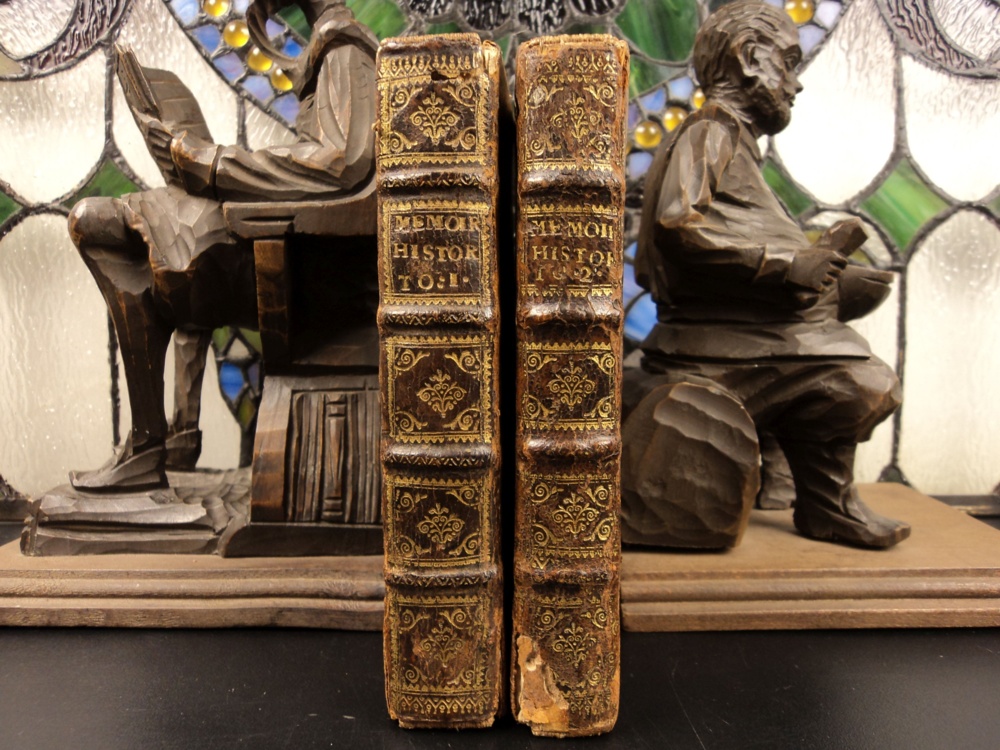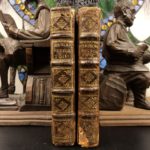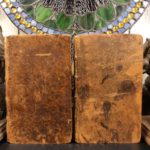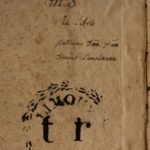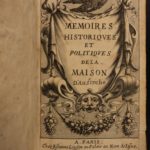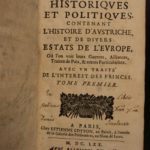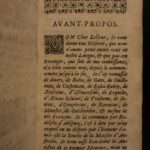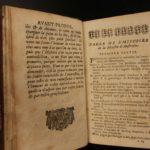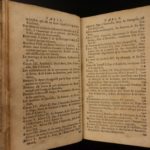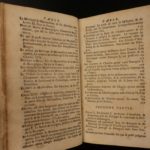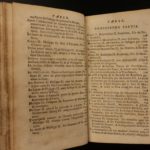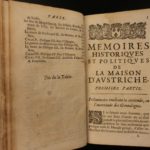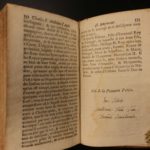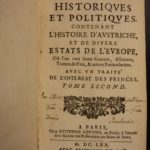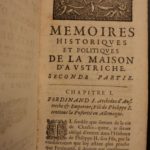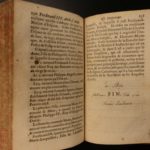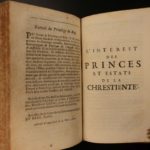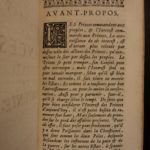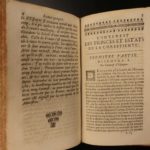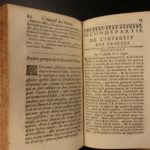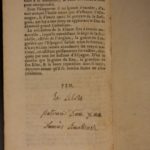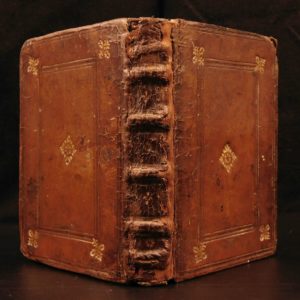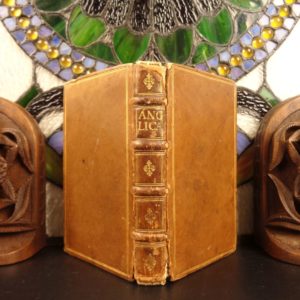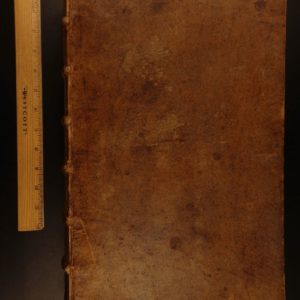1670 Habsburg Memoirs AUSTRIA Leopold II Holy Roman Empire 2v SET European Wars
This book is the history of politics in Austria through the middle of the 17th-century including the reigns of major European powers such as Maximillian I, Phillipe II, Leopold II, and Charles I
We do not find another example of this very rare printing for sale worldwide
1670 Habsburg Memoirs AUSTRIA Leopold II Holy Roman Empire 2v SET European Wars
Complete 2 volume History of Austria / NONE Found
This book is the history of politics in Austria through the middle of the 17th-century including the reigns of major European powers such as Maximillian I, Phillipe II, Leopold II, and Charles I
We do not find another example of this very rare printing for sale worldwide
Main author: Claude Du Bosc de Montandré (1643-1715)
Title: Mémoires historiques et politiques, contenant l’histoire d’Austriche et de divers Estats de l’Europe : où l’on voit leurs guerres, alliances, traitez de paix, & autres particularitez. Avec un Traité de l’interest des princes. Tome premier [-second].
Published: Paris, chez Estienne Loyson, au Palais, à l’entrée de la galerie des prisonniers, au nom de Jesus. M. DCC. LXX. Avec Privilege du Roy, [1670]
Language: French
Notes & contents:
- 1 copper engraving (frontis)
- Complete 2 volume set
- Leopold II, Austria
- Maximilian I, Austria
- Charles I, Holy Roman Empire
- Ferdinand, I, Spain
- Philippe II, Spain
- State of Christianity
FREE SHIPPING WORLDWIDE
Wear: wear as seen in photos
Binding: tight and secure leather binding
Illustrated: frontispiece
Pages: complete with all 333 + 252 + 68 pages; plus indexes, prefaces, and such
Publisher: Paris, chez Estienne Loyson, au Palais, à l’entrée de la galerie des prisonniers, au nom de Jesus. M. DCC. LXX. Avec Privilege du Roy, [1670]
FREE SHIPPING WORLDWIDE
Shipping:
Very Fast. Very Safe. Free Shipping Worldwide.
Satisfaction Guarantee:
Customer satisfaction is our first priority. Notify us within 7 days of receiving your item and we will offer a full refund guarantee without reservation.
$599
Leopold II (German: Peter Leopold Josef Anton Joachim Pius Gotthard; Italian: Pietro Leopoldo Giuseppe Antonio Gioacchino Pio Gottardo; English: Peter Leopold Joseph Anthony Joachim Pius Godehard; 5 May 1747 – 1 March 1792), was Holy Roman Emperor and King of Hungary and Bohemia from 1790 to 1792, Archduke of Austria and Grand Duke of Tuscany from 1765 to 1790. He was a son of Emperor Francis I and his wife, Empress Maria Theresa, thus the brother of Marie Antoinette. Leopold was a moderate proponent of enlightened absolutism.[1]
Contents [hide]
1 Youth
2 Grand Duke of Tuscany
3 Holy Roman Emperor
4 Full title
5 Ancestors
6 Issue
7 Titles, styles, honours and arms
7.1 Titles and styles
8 See also
9 References
10 Notes
11 External links
Youth[edit]
Leopold as a youth drawing fortifications by Jean-Étienne Liotard, 1762, Geneva, Musée d’Art et d’Histoire
Leopold was born in Vienna, the third son, and was at first educated for the priesthood, but the theological studies to which he was forced to apply himself are believed to have influenced him against the Church.[clarification needed][citation needed]
In 1753, he was engaged to Maria Beatrice d’Este, heiress to the Duchy of Modena. The marriage never materialised; Maria Beatrice instead married Leopold’s brother, Archduke Ferdinand.
On the death of his elder brother, Charles, in 1761, it was decided that he should succeed to his father’s grand duchy of Tuscany, which was erected into a “secundogeniture” or apanage for a second son. This settlement was the condition of his marriage on 5 August 1764 with Infanta Maria Luisa of Spain, daughter of Charles III of Spain and Maria Amalia of Saxony. On the death of his father, Francis I (18 August 1765), he succeeded to the grand duchy. Leopold was famous in Florence for his numerous extra-marital affairs. Among his lovers was Countess Cowper, wife of the 3rd Earl Cowper, who in compensation for being cuckolded was given honours by Leopold’s brother, Joseph II.
Grand Duke of Tuscany[edit]
Leopold (left) with his brother Emperor Joseph II, by Pompeo Batoni, 1769, Vienna, Kunsthistorisches Museum
For five years, he exercised little more than nominal authority, under the supervision of counselors appointed by his mother. In 1770, he made a journey to Vienna to secure the removal of this vexatious guardianship and returned to Florence with a free hand. During the twenty years which elapsed between his return to Florence and the death of his eldest brother Joseph II in 1790, he was employed in reforming the administration of his small state. The reformation was carried out by the removal of the ruinous restrictions on industry and personal freedom imposed by his predecessors of the house of Medici and left untouched during his father’s life, by the introduction of a rational system of taxation (reducing the rates of taxation), and by the execution of profitable public works, such as the drainage of the Val di Chiana.
As he had no army to maintain, and as he suppressed the small naval force kept up by the Medici, the whole of his revenue was left free for the improvement of his state. Leopold was never popular with his Italian subjects. His disposition was cold and retiring. His habits were simple to the verge of sordidness, though he could display splendour on occasion, and he could not help offending those of his subjects who had profited by the abuses of the Medicean régime.
But his steady, consistent, and intelligent administration, which advanced step by step, brought the grand duchy to a high level of material prosperity. His ecclesiastical policy, which disturbed the deeply rooted convictions of his people and brought him into collision with the pope, was not successful. He was unable to secularize the property of the religious houses or to put the clergy entirely under the control of the lay power. However, his abolition of capital punishment was the first permanent abolition in modern times. On 30 November 1786, after having de facto blocked capital executions (the last was in 1769), Leopold promulgated the reform of the penal code that abolished the death penalty and ordered the destruction of all the instruments for capital execution in his land. Torture was also banned.[2]
Leopold also approved and collaborated on the development of a political constitution, said to have anticipated by many years the promulgation of the French constitution and which presented some similarities with the Virginia Bill of Rights of 1778. Leopold’s concept of this was based on respect for the political rights of citizens and on a harmony of power between the executive and the legislative. However, it could not be put into effect because Leopold moved to Vienna to become emperor in 1790, and because it was so radically new that it garnered opposition even from those who might have benefited from it.[3]
Leopold as a young man by Anton Raphael Mengs, 1770, Madrid, Museo del Prado
However, Leopold developed and supported many social and economic reforms. Smallpox inoculation was made systematically available, and an early institution for the rehabilitation of juvenile delinquents was founded. Leopold also introduced radical reforms to the system of neglect and inhumane treatment of those deemed mentally ill. On 23 January 1774, the “legge sui pazzi” (law on the insane) was established, the first of its kind to be introduced in all Europe, allowing steps to be taken to hospitalize individuals deemed insane. A few years later Leopold undertook the project of building a new hospital, the Bonifacio Hospital (it). He used his skill at choosing collaborators to put a young physician, Vincenzo Chiarugi, at its head. Chiarugi and his collaborators introduced new humanitarian regulations in the running of the hospital and caring for the mentally ill patients, including banning the use of chains and physical punishment, and in so doing have been recognized as early pioneers of what later came to be known as the moral treatment movement.[3]
During the last few years of his rule in Tuscany, Leopold had begun to be frightened by the increasing disorders in the German and Hungarian dominions of his family, which were the direct result of his brother’s headlong methods. He and Joseph II were tenderly attached to one another and met frequently both before and after the death of their mother. The portrait by Pompeo Batoni in which they appear together shows that they bore a strong personal resemblance to one another. But it may be said of Leopold, as of Fontenelle, that his heart was made of brains. He knew that he must succeed his childless eldest brother in Austria, and he was unwilling to inherit his unpopularity. When, therefore, in 1789 Joseph, who knew himself to be dying, asked him to come to Vienna and become co-regent, Leopold coldly evaded the request.
He was still in Florence when Joseph II died at Vienna on 20 February 1790, and he did not leave his Italian capital until 3 March 1790, at midday.
Holy Roman Emperor[edit]
Leopold II in coronation robes
Leopold, during his government in Tuscany, had shown a speculative tendency to grant his subjects a constitution. When he succeeded to the Austrian lands, he began by making large concessions to the interests offended by his brother’s innovations. He recognized the Estates of his different dominions as “the pillars of the monarchy”, pacified the Hungarians and Bohemians, and divided the insurgents in the Austrian Netherlands (now Belgium) by means of concessions. When these failed to restore order, he marched troops into the country and re-established his own authority, and at the same time the historic franchises of the Flemings. Yet he did not surrender any part that could be retained of what Maria Theresa and Joseph had done to strengthen the hands of the state. He continued, for instance, to insist that no papal bull could be published in his dominions without his consent (placetum regium). One of the harshest actions Leopold took to placate the noble communities of the various Habsburg domains was to issue a decree on 9 May 1790, that forced thousands of Bohemian serfs freed by his brother Joseph back into servitude.
Leopold lived for barely two years after his accession as Holy Roman Emperor, and during that period he was hard pressed by peril from west and east alike. The growing revolutionary disorders in France endangered the life of his sister Marie Antoinette of Austria, the queen of Louis XVI, and also threatened his own dominions with the spread of subversive agitation. His sister sent him passionate appeals for help, and he was pestered by the royalist émigrés, who were intriguing to bring about armed intervention in France.
The Leopoldsäule is a memorial of the coronation of 1790 in Frankfurt am Main
From the east he was threatened by the aggressive ambition of Catherine II of Russia and by the unscrupulous policy of Prussia. Catherine would have been delighted to see Austria and Prussia embark on a crusade in the cause of kings against the French Revolution. While they were busy beyond the Rhine, she would have annexed what remained of Poland and made conquests against the Ottoman Empire. Leopold II had no difficulty in seeing through the rather transparent cunning of the Russian empress, and he refused to be misled.
To his sister, he gave good advice and promises of help if she and her husband could escape from Paris. The émigrés who followed him pertinaciously were refused audience, or when they forced themselves on him, were peremptorily denied all help. Leopold was too purely a politician not to be secretly pleased at the destruction of the power of France and of her influence in Europe by her internal disorders. Within six weeks of his accession, he displayed his contempt for France’s weakness by practically tearing up the treaty of alliance made by Maria Theresa in 1756 and opening negotiations with Great Britain to impose a check on Russia and Prussia.
Leopold put pressure on Great Britain by threatening to cede his part of the Low Countries to France. Then, when sure of British support, he was in a position to baffle the intrigues of Prussia. A personal appeal to Frederick William II led to a conference between them at Reichenbach in July 1790, and to an arrangement which was in fact a defeat for Prussia: Leopold’s coronation as king of Hungary on 11 November 1790, preceded by a settlement with the Diet in which he recognized the dominant position of the Magyars. He had already made an eight months’ truce with the Turks in September, which prepared the way for the termination of the war begun by Joseph II. The pacification of his eastern dominions left Leopold free to re-establish order in Belgium and to confirm friendly relations with Britain and the Netherlands.
During 1791, the emperor remained increasingly preoccupied with the affairs of France. In January, he had to dismiss the Count of Artois (afterwards Charles X of France) in a very peremptory way. His good sense was revolted by the folly of the French émigrés, and he did his utmost to avoid being entangled in the affairs of that country. The insults inflicted on Louis XVI and Marie Antoinette, however, at the time of their attempted flight to Varennes in June, stirred his indignation, and he made a general appeal in the Padua Circular to the sovereigns of Europe to take common measures in view of events which “immediately compromised the honour of all sovereigns, and the security of all governments.” Yet he was most directly interested in negotiations with Turkey, which in June led to a final peace, the Treaty of Sistova being signed in August 1791.
Portrait of Emperor Leopold II, shortly before his death (by Heinrich Friedrich Füger)
On 25 August 1791, he met the king of Prussia at Pillnitz Castle, near Dresden, and they drew up the Declaration of Pillnitz, stating their readiness to intervene in France if and when their assistance was called for by the other powers. The declaration was a mere formality, for, as Leopold knew, neither Russia nor Britain was prepared to act, and he endeavored to guard against the use which he foresaw the émigrés would try to make of it. In face of the reaction in France to the Declaration of Pillnitz, the intrigues of the émigrés, and attacks made by the French revolutionists on the rights of the German princes in Alsace, Leopold continued to hope that intervention might not be required. When Louis XVI swore to observe the constitution of September 1791, the emperor professed to think that a settlement had been reached in France. The attacks on the rights of the German princes on the left bank of the Rhine, and the increasing violence of the parties in Paris which were agitating to bring about war, soon showed, however, that this hope was vain. Leopold meant to meet the challenge of the revolutionists in France with dignity and temper, however the effect of the Declaration of Pillnitz was to contribute to the radicalization of their political movement.
He died suddenly in Vienna, in March 1792, although some claimed he was poisoned or secretly murdered.[4]
Sarcophagus of Leopold II in Kapuzinergruft, in Vienna, Austria
Like his parents before him, Leopold had sixteen children, the eldest of his eight sons being his successor, Emperor Francis II. Some of his other sons were prominent personages in their day. Among them were: Ferdinand III, Grand Duke of Tuscany; Archduke Charles of Austria, a celebrated soldier; Archduke Johann of Austria, also a soldier; Archduke Joseph, Palatine of Hungary; and Archduke Rainer, Viceroy of Lombardy-Venetia.
Mozart’s opera La clemenza di Tito was commissioned by the Estates of Bohemia for the festivities that accompanied Leopold’s coronation as king of Bohemia in Prague on 6 September 1791.[5] Joseph František Maximilian, 7th Prince Lobkowicz, commissioned a reconstruction of the Lobkowicz Palace’s exterior in honor of the coronation, giving the palace the appearance that it retains to this day.
Categories
Law & Government
Military & War
Authors
Claude Du Bosc de Montandré (1643-1715)
Printing Date
17th Century
Language
French
Binding
Leather
Book Condition
Good
Collation
Complete

